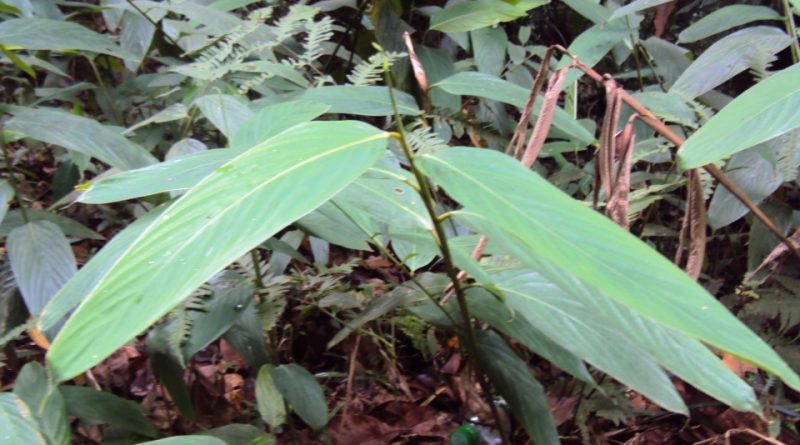Indianthus virgatus
Indianthus virgatus
The flower of India or kattukuva (Indianthus virgatus (Roxb.) Suksathan & Borchs., 2009) is a herbaceous species belonging to the Marantaceae family.
Systematic –
From a systematic point of view it belongs to:
Eukaryota domain;
Kingdom Plantae;
Division Magnoliophyta;
Class Liliopsida;
Zingiberales Order;
Family Marantaceae;
Genus Indianthus,
Species I. virgatus.
The term is basionym:
– Phrynium virgatum Roxb..
The terms are synonymous:
– Arundastrum virgatum (Roxb.) Kuntze;
– Clinogyne virgata (Roxb.) Benth. & Hook.f.;
– Donax virgata (Roxb.) K.Schum.;
– Maranta virgata (Roxb.) A.Dietr.;
– Maranta virgata (Roxb.) Wall.;
– Maranta virgata (Roxb.) Wight
– Phyllodes virgata (Roxb.) Kuntze;
– Schumannianthus virgatus (Roxb.) Rolfe.
Etymology –
The term Indianthus comes from the combination of “India” and the Greek word “ἄνθος” (ánthos), meaning flower.
The specific epithet virgatus comes from the Latin “virgatus, a, um”, i.e. woven wicker.
Geographic Distribution and Habitat –
Indianthus virgatus is a plant native to an area that includes southern India (Eastern Ghats), Sri Lanka and the Andaman Islands.
The habitat of this rhizomatous geophytic plant is mainly that of the humid tropical biome, where it grows in marshy areas and along the banks of watercourses in the undergrowth of humid deciduous and semi-deciduous forests, up to approximately 1000 m above sea level.
Description –
Indianthus virgatus is a herbaceous, rhizomatous, perennial, evergreen plant.
The plant is characterized by forming dense tufts with simple, thin stems, 1.5-4 m high. The leaves are located on a petiole about 1 cm long; they are couplets, lanceolate in shape, with entire margin and cuspidate apex, bright green in colour, leathery; they are 15-45 cm long and 4-15 cm wide.
The flowers are grouped in terminal, panicle-shaped inflorescences, up to about 50 cm long, dichotomous, with thin ramifications.
The flowers are white, odorless, in pairs, subtended by a lanceolate green bract, about 4 cm long and 0.5 cm wide. The sepals are deciduous, short, lanceolate with a pointed apex, a corolla with a shorter tube than the sepals and 3 oblong lobes, 2 obovate external petaloid staminodes, about 1.5 cm long, the internal ones slightly smaller and a trilocular ovary.
The fruits are green, obovoid-shaped berries.
Cultivation –
Indianthus virgatus is a plant little known outside its areas of origin. In these areas it is almost exclusively present in botanical gardens.
It can be grown in tropical and humid subtropical climate areas.
For cultivation it needs full sun or partial shade.
From a pedological point of view it needs soils that are kept constantly humid but draining.
Reproduction occurs by seed, but usually propagates easily by division.
Customs and Traditions –
Indianthus virgatus is a plant that is not widespread outside its range so the common names are those of the areas of origin; among these we report: pogina yele (kannada); kooelé (kodava); kattukuva, pandikuva (Malayalam); geta-oluwa (sinhala); periya kuhai vazai (Tamil).
From this plant fibers are obtained from the stems which are locally used to make mats, hats, handicrafts and in paper making.
The leaves, which are particularly resistant, are used by some populations to wrap and cook foods which give them a particular aroma.
The plant is also used in folk medicine.
In particular, leaves and rhizomes are used in traditional medicine for various pathologies; some laboratory studies have highlighted the presence of bioactive compounds with antioxidant and hepatoprotective properties in rhizome extracts worthy of further study for possible use in the official pharmacopoeia.
Preparation Method –
Indianthus virgatus is a plant that is used in its areas of origin both in the food and medicinal fields or as materials for various uses.
In the food sector, the leaves are used to wrap and cook foods, giving them a particular aroma.
In the medicinal field, leaves and rhizomes are used for traditional uses.
Guido Bissanti
Sources
– Acta Plantarum – Flora of the Italian Regions.
– Wikipedia, the free encyclopedia.
– GBIF, the Global Biodiversity Information Facility.
– Useful Tropical Plants Database.
– Conti F., Abbate G., Alessandrini A., Blasi C. (ed.), 2005. An annotated checklist of the Italian vascular flora, Palombi Editore.
– Pignatti S., 1982. Flora d’Italia, Edagricole, Bologna.
– Treben M., 2000. Health from the Lord’s Pharmacy, Advice and experiences with medicinal herbs, Ennsthaler Editore.
Photo source:
– https://upload.wikimedia.org/wikipedia/commons/2/27/Schumannianthus_virgatus_21.JPG
– https://www.ifpindia.org/hifp/images/HIFP_022368.JPG
Attention: Pharmaceutical applications and food uses are indicated for informational purposes only, they do not represent in any way a medical prescription; we therefore decline any responsibility for their use for healing, aesthetic or food purposes.


